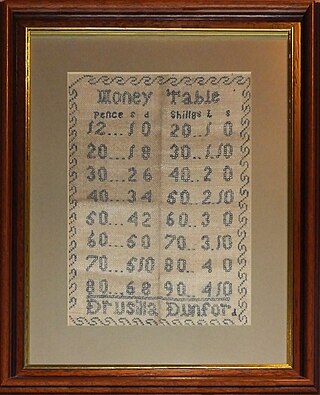
Jewellery consists of decorative items worn for personal adornment, such as brooches, rings, necklaces, earrings, pendants, bracelets, and cufflinks. Jewellery may be attached to the body or the clothes. From a western perspective, the term is restricted to durable ornaments, excluding flowers for example. For many centuries metal such as gold often combined with gemstones, has been the normal material for jewellery, but other materials such as glass, shells and other plant materials may be used.

Numismatics is the study or collection of currency, including coins, tokens, paper money, medals and related objects.
Nadsat is a fictional register or argot used by the teenage gang members in Anthony Burgess's dystopian novel A Clockwork Orange. Burgess was a linguist and he used this background to depict his characters as speaking a form of Russian-influenced English. The name comes from the Russian suffix equivalent of -teen as in thirteen. Nadsat was also used in Stanley Kubrick's film adaptation of the book.

Cameo is a method of carving an object such as an engraved gem, item of jewellery or vessel. It nearly always features a raised (positive) relief image; contrast with intaglio, which has a negative image. Originally, and still in discussing historical work, cameo only referred to works where the relief image was of a contrasting colour to the background; this was achieved by carefully carving a piece of material with a flat plane where two contrasting colours met, removing all the first colour except for the image to leave a contrasting background.

£sd, spoken as "pounds, shillings and pence", is the popular name for the pre-decimal currencies once common throughout Europe. The abbreviation originates from the Latin currency denominations librae, solidi, and denarii. In the United Kingdom, these were referred to as pounds, shillings, and pence.

Henry Wheeler Shaw, better known by the pen name Josh Billings, was a 19th-century American humorist and lecturer.

Charles Godfrey Leland was an American humorist and folklorist, born in Philadelphia, Pennsylvania. He was educated at Princeton University and in Europe.

Chimor was the political grouping of the Chimú culture. The culture arose about 900 CE, succeeding the Moche culture, and was later conquered by the Inca emperor Topa Inca Yupanqui around 1470, fifty years before the arrival of the Spanish in the region. Chimor was the largest kingdom in the Late Intermediate Period, encompassing 1,000 kilometres (620 mi) of coastline.

Terms used to describe homosexuality have gone through many changes since the emergence of the first terms in the mid-19th century. In English, some terms in widespread use have been sodomite, Achillean, Sapphic, Uranian, homophile, lesbian, gay, effeminate, queer, homoaffective, and same-gender attracted. Some of these words are specific to women, some to men, and some can be used of either. Gay people may also be identified under the umbrella term LGBT.
Shell money is a medium of exchange similar to coin money and other forms of commodity money, and was once commonly used in many parts of the world. Shell money usually consisted of whole or partial sea shells, often worked into beads or otherwise shaped. The use of shells in trade began as direct commodity exchange, the shells having use-value as body ornamentation. The distinction between beads as commodities and beads as money has been the subject of debate among economic anthropologists.
The history of money is the development over time of systems for the exchange, storage, and measurement of wealth. Money is a means of fulfilling these functions indirectly and in general rather than directly, as with barter.

A sycee or yuanbao was a type of gold and silver ingot currency used in imperial China from its founding under the Qin dynasty until the fall of the Qing in the 20th century. Sycee were not made by a central bank or mint but by individual goldsmiths or silversmiths for local exchange; consequently, the shape and amount of extra detail on each ingot were highly variable. Square and oval shapes were common, but boat, flower, tortoise and others are known. Their value—like the value of the various silver coins and little pieces of silver in circulation at the end of the Qing dynasty—was determined by experienced moneyhandlers, who estimated the appropriate discount based on the purity of the silver and evaluated the weight in taels and the progressive decimal subdivisions of the tael.

Money is any item or verifiable record that is generally accepted as payment for goods and services and repayment of debts, such as taxes, in a particular country or socio-economic context. The primary functions which distinguish money are: medium of exchange, a unit of account, a store of value and sometimes, a standard of deferred payment.
The word dentalium, as commonly used by Native American artists and anthropologists, refers to tooth shells or tusk shells used in indigenous jewelry, adornment, and commerce in western Canada and the United States. These tusk shells are a kind of seashell, specifically the shells of scaphopod mollusks. The name "dentalium" is based on the scientific name for the genus Dentalium, but because the taxonomy has changed over time, not all of the species used are still placed in that genus; however, all of the species are certainly in the family Dentaliidae.
British slang is English-language slang originating from and used in the United Kingdom and also used to a limited extent in Anglophone countries such as India, Malaysia, Ireland, South Africa, Australia, Canada, and New Zealand, especially by British expatriates. It is also used in the United States to a limited extent. Slang is informal language sometimes peculiar to a particular social class or group and its use in Britain dates back to before the 15th century. The language of slang, in common with the English language, is changing all the time; new words and phrases are being added and some are used so frequently by so many, they almost become mainstream.
John Camden Hotten was an English bibliophile and publisher. He is best known for his clandestine publishing of numerous erotic and pornographic titles.
Slang terms for money often derive from the appearance and features of banknotes or coins, their values, historical associations or the units of currency concerned. Within a language community, some of the slang terms vary in social, ethnic, economic, and geographic strata but others have become the dominant way of referring to the currency and are regarded as mainstream, acceptable language.

Native American jewelry refers to items of personal adornment, whether for personal use, sale or as art; examples of which include necklaces, earrings, bracelets, rings and pins, as well as ketohs, wampum, and labrets, made by one of the Indigenous peoples of the United States. Native American jewelry normally reflects the cultural diversity and history of its makers, but tribal groups have often borrowed and copied designs and methods from other, neighboring tribes or nations with which they had trade, and this practice continues today. Native American tribes continue to develop distinct aesthetics rooted in their personal artistic visions and cultural traditions. Artists may create jewelry for adornment, ceremonies, and display, or for sale or trade. Lois Sherr Dubin writes, "[i]n the absence of written languages, adornment became an important element of Indian communication, conveying many levels of information." Later, jewelry and personal adornment "...signaled resistance to assimilation. It remains a major statement of tribal and individual identity."

The staurogram (⳨), also monogrammatic cross or tau-rho, is a ligature composed of a superposition of the Greek letters tau (Τ) and rho (Ρ).












